पशु पालन के साथ मत्स्य पालन की एकीकृत कृषि पद्धति
Integration of livestock in fish culture is an old age system of practice. Ducks, poultry, pig, cattle, buffalo, sheep and goat are common in mixed farming. Nowadays rabbit also incorporated in integrated livestock cum fish culture.
Due to progressive shrinking of farm holding to obtain maximum output adoption of mixed farming system with livestock and fish become very popular in wetland and water shed areas of the country. The by-product utilization of one sub-system e.g. excreta of livestock becomes an input to a second sub-system i.e. in fish culture.
To avoid environmental problems with animal excreta apart from manure production the animal excreta could be efficiently utilized as feed for fish and the end product is valuable animal protein, which is very much needed in India. States like West Bengal. Orissa, Bihar, Jharkhand, Andhra Pradesh, Assam and North Eastern states the demand for fish and fish products along with meat and animal products are very high.
To meet the demand and supply the integration with fish and livestock is very promising and could bring a significant profitability from a unit area particularly for small holding farmers.
Most of the small holder farmers cannot afford the concentrate feed requirements of the fishes in intensive fish farming. Hence, the integrated fish farming with livestock and utilization of livestock excreta could meet demand by growing fish food organism i.e. plankton in the pond or water bodies along with direct feeding of animal waste. The popular livestock- fish integrated farming systems are –
- Duck- fish integration system
- Poultry- fish integration system
- Pig- fish integration system
- Sheep/Goat- fish integration system
- Cattle- fish integration system
- Buffalo- fish integration system
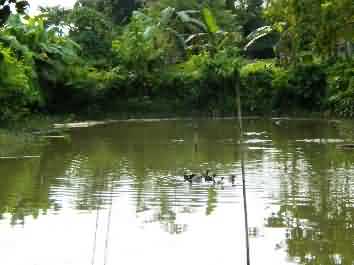
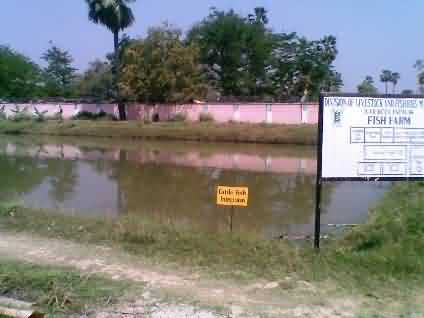
Basic principles for integrated livestock-fish farming
The basic principles for livestock-fish integrated farming system are full utilization of livestock farm wastes and conversion of waste in to valuable fish protein. The spilled over feed or feed derived from livestock manure may be utilized as direct feed or the manure from livestock helps in production of planktons which form the feed for fishes in the pond.
In this integrated farming system optimal stocking density with desired fish species, optimum utilization of manure and lime also play an important role for successful production of fish. Excess manuring with livestock excreta may cause poor water quality and may lead to depletion of dissolved oxygen in water causing mortality to fishes. The livestock-fish farming may be extensive, intensive or semi-intensive system depending upon the availability of resources and capital.
Fish species for integrated livestock-fish farming
The most suitable species of fishes for integrated livestock-fish farming are those fishes that can filter and feed on phytoplankton, zooplankton and bacteria from water. The objective of integrated livestock cum fish farming is to produce maximum plankton in water through manuring which is rich in protein and a natural feed for fishes.
The species of fishes which are consumed by the people and are efficient utilizer of phyto and zooplankton and also with macrophytic feeding nature are excellent for integrated livestock fish culture. Depending on the feeding nature the fishes are divided into three categories viz. Surface feeder, Column feeder and Bottom feeder.
In integrated system of fish farming both indigenous and exotic species are recommended. Indigenous species like Catla (Catla catla) which are zooplankton feeder and exotic species Silver carp (Hypophthalmichthys molitrix) which are phytoplankton consumer are best example of surface feeder, whereas Rohu (Labio rohita) an indigenous species is omnivorous in nature and column feeder.
The indigenous species Mrigal (Cirrhinus mrigala), Kalabasu (Labeo calbasu) are detritivorous and common carp (Cyprinus carpio) an exotic species which are detritivorous/ omnivorous in nature are bottom feeder. Exotic species like Grass carp (Ctenopharyngodon idella) which are herbivorous cover surface, column and marginal area of feeding zone.
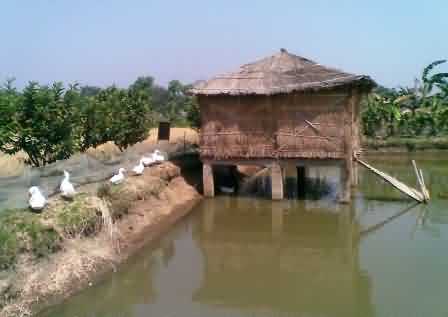
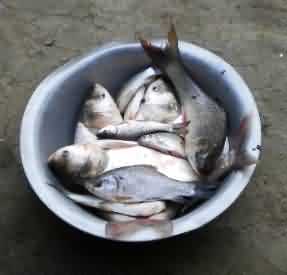
Ideal housing for livestock- fish integrated farming system
Considering the easy operation of day to day farm management and optimum production the livestock house is constructed above the water bodies especially for duck or poultry, nearby the pond or bank of pond for pig, poultry, cattle or buffaloes etc or partly in water and land.
In duck cum fish farming the duck house may be constructed above the pond thus the excreta and feed waste directly goes to the pond and serve as a feed for fishes. When the house is constructed in bank of the water bodies, a channel is diverted from animal shed to the pond, so that the feed waste or excreta rinsed to the pond.
In this case optimum livestock-fish ratio should be maintained to avoid excess manuring in water. In this type of housing duck, poultry, pig or cattle is recommended. In third type i.e. slatted floor is considered for both birds and animals like pigs. The animal excreta channelized in the pond directly. The slatted type floor may be constructed with wood, bamboo etc.
Management of pond in integrated livestock-fish system
The pond should be water retentive and not to be situated in flood prone area. There should be constant water supply or throughout the year there should be water in the pond. Seasonal ponds, which can retain 8 to 9 month water also, can be considered for integrated farming system. At least there should be 1.0 m of water and ideal is 1.5 to 3.0 m.
Soil pH should be within the range of 6.5 to 7.5. If the soil pH is not up to the desired level, the pH may be corrected by application of lime and the quantity of lime is 2000 kg/ ha for 4.0 to 5.0 pH, 1200 kg for 5.1 to 6.0, 1000 kg for 6.1 to 6.5 (mild acidic), 400 kg for 6.6 to 7.0 (more or less neutral) and 200 kg/ ha for pH 7.1 to 7.5, which is mildly alkaline.
Lime helps in maintaining pH, kills and decomposes parasites. The lime should be applied in 3 to 4 split doses.The basal dose of lime and cow dung application in per hectare of water bodies is 1200 kg and 5000 kg, respectively. The pond should be regularly cleaned from aquatic plants which prevents sunlight penetration and oxygen circulation in water as well as shelter fish predators.
The weeding can be done by manually, mechanically, biologically, chemically or by increasing the water depth in the pond. To kill predatory fishes Mahua (Bassicala tifolia) may be applied at the rate of 2500 kg/ ha of water bodies. By repeated netting unwanted fishes may also be removed. The ammonia, tea seed cake and bleaching powder also can be applied to remove enemy fishes.
Stocking and harvesting time of fishes
June and July is the best suitable months for stocking of fingerlings. The stocking time varies depending upon the climate in different regions of the country and also the availability of optimum water level in pond.
Below 18 to 20⁰C growth of the fishes restricted. During winter months growth is slow but in rainy season faster growth observed in fishes. Moreover, in winter months and in dry season water level comes down drastically in the water bodies. It is advisable to stocking fingerlings after winter months i.e. in rainy season and harvested before the water scarcity in pond. Generally, fishes are harvested after 12 months of stocking.
But, where water bodies remain functional for 8 to 9 months fingerlings may be stocked in April and harvested in the month of November/ December. In composite fish culture 3 species, 4 species or 6 species may be stocked depending upon the availability of fingerlings in the market. In integrated livestock cum fish farming considering the surface, column and bottom feeder the ratio of fishes viz. Catla, Rohu and Mrigal should be 4: 3: 3 (3 species), in 4 species Catla, Rohu, Mrigal and Common carp ratio 3 : 3 : 3 : 2 whereas, in 6 species Catla, Rohu, Mrigal, Silver carp, Grass carp and Common carp ratio should be 1.5 : 2.0 : 1.5 : 1.5 : 1.5 : 2.0, respectively.
For example, as Catla and Silver carp are surface feeder, the combined stocking density should not be more than 30 to 35%, but for Rohu which is column feeder grows well in ponds with 3 to 4 m water depth should be stocked at the rate of 15 to 20%, whereas, bottom feeder like Mrigal and Common carp the ratio may be 40 to 45%.
Grass carp should not be more than 5 to 10%, which can be fed with land grasses, vegetable refuse, banana leaves (practiced at ICAR RC ER, Patna) or with aquatic plants.
Central Inland Fisheries Research Institute and ICAR Research Complex for NEH Region, Barapani recommended 6000 fingerlings/ ha for duck-fish integrated system and 6000 to 7000 fingerlings for integrated and non-integrated pig-fish farming system, respectively.
Potentiality of livestock manure in integrated fish farming
Livestock excreta contain about 70 to 80% water and 20 to 25% dry matter. A cow produces 15 to 18 kg dung/ day. A poultry layer bird can produce 68 kg of excreta per year. A pig of 50 kg can produce 2.5 kg dung per day whereas; 90 kg pig produces 5 kg dung per day. Livestock excreta generally used as a potential manure in agricultural production system.
It is rich in Nitrogen (N), Phosphorous (P) and Potassium (K) and also contains micronutrients. Thus, it makes the soil fertile. The average dung production in different animals varies according to their body size, body weight and feed and water consumption. In domestic animals like sheep, goat, cattle, buffalo, pig and poultry manure production is 0.15, 0.15, 1.10, 1.35, 0.25, and 0.014 tonnes/ animal/ year, respectively on dry weight basis.
The N, P, K level in excreta varies in different species of animals. Like sheep/ goat 0.65, 0.50 and 0.03%, cattle 0.15, 0.01 and 0.05%, pig 0.60, 0.50 and 0.20%, poultry 0.76, 0.63 and 0.22%, duck 0.91, 0.38 and 0.36%, respectively.
Types of Livestock- Fish integrated farming system
Duck cum fish farming- This system is very popular and widely practiced in our country particularly in Assam, West Bengal, Bihar, Orissa, Andhra Pradesh, Kerala and in North Eastern States. It is one of the best livestock – fish integration system.
Duck droppings directly fall in water or collected and used for fertilization in pond. Fish gather duck droppings as direct food or consume spilled feed. Ducks consume mosquito larvae, tadpoles, dragon fly larvae and snails which also serve as vector for certain parasites.
The dabbling habit of ducks increases the available oxygen in pond water. For commercial farming or for maximum profit high egg producing ducks like Khaki Campbell or Indian Runner is preferred instead of local ducks. About 200 to 240 eggs/ duck/ year is expected for commercial farming and on an average 250 ducks/ ha is recommended for duck cum fish farming.
Poultry cum fish farming- Poultry excreta is an excellent feed for fish as it contains highly soluble organic salts, more N and P as compared to other livestock manure. Broiler or layer bird can be raised in the integrated system. It was found suitable even with dual purpose poultry birds like Vanaraja. For one hectre fish pond 500 to 600 birds and on an average 60 kg poultry manure is required per day.
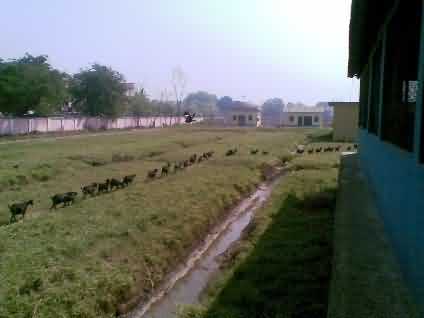 Sheep/goat cum fish farming- Fifty to fifty five goats are sufficient for one hectre water bodies for sheep/goat integrated farming system. Sheep/goat manure is also rich in N, P and K.
Sheep/goat cum fish farming- Fifty to fifty five goats are sufficient for one hectre water bodies for sheep/goat integrated farming system. Sheep/goat manure is also rich in N, P and K.
Moreover, there is a great demand for mutton and chevon and no religious taboo is attached with these meats.
Cattle/buffalo cum fish farming- This system is very common in rural India. People generally mix cow dung with paddy husk or wheat bhusa and spread over water bodies as a ready source of fish food.
Sometimes cow dung and cattle/ buffalo shed waste channelized directly in to the pond which serve as excellent fish food directly or indirectly as a source of plankton growth in the pond. But, caution should be taken for number of animals per unit of water bodies; otherwise there may be fish mortality due to excess manure in water. Five cattle/buffaloes are considered sufficient for one hectre of water bodies.
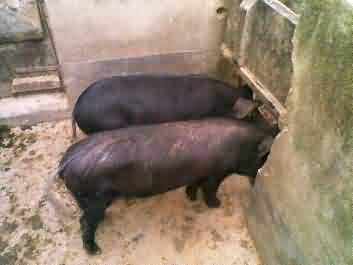 Pig cum fish integration- Pig manure is very suitable for integrated fish farming system. Generally pig house is constructed in the bank of pond and wastes are directly channelized in to the water.
Pig cum fish integration- Pig manure is very suitable for integrated fish farming system. Generally pig house is constructed in the bank of pond and wastes are directly channelized in to the water.
Sometimes pig manure is accumulated and fermented for some days and then applied in pond.
If channelized system is practiced there is no need for supplementing feed for fish. The spillover feed and pig manure is sufficient for fish farming. Pig manure is rich in nitrogen and phosphorus and thus it helps in very fast growth of fingerlings. About 30 to 40 pigs are recommended for one hectre of water bodies. This type of integration is very profitable when good quality of pig variety like Large and Middle white Yorkshire, Barkshire, Duroc, Hereford, Landrace, Chesterwhite, Tamworth etc are introduced in integrated fish farming.
Authors:
Dr Asit Chakrabarti¹, Dr AmitavaDey ², Dr Dharmendra Kumar ³
¹ Senior Scientist (LPM), ² Principal Scientist (Anim. Nutri.) & Head, ³ SMS, KVK, Kishanganj
Division of Livestock & Fishery Management, ICAR Research Complex for Eastern Region
ICAR Parisar, P.O. Bihar Veterinary College, Patna- 800014, Bihar
1 E-mail:
